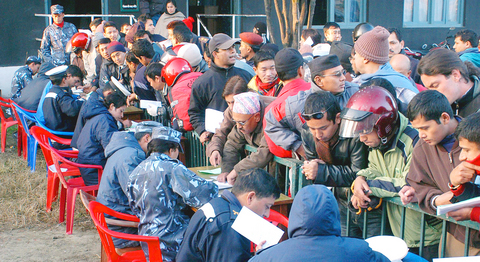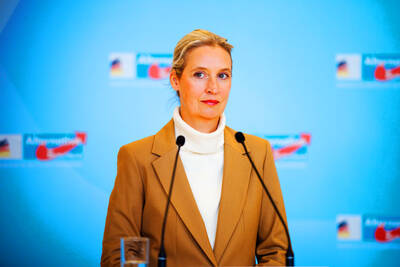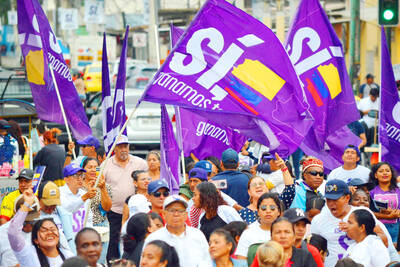Kathmandu was deserted yesterday as police and soldiers enforced a daytime curfew declared by the Nepalese government after a round-up of political activists aimed at heading off anti-king protests.
Some 120 people were detained for breaking the curfew, among them political activists, protesters and civilians, a police officer said.
Most of the civilians would be freed in the evening, he said without clarifying how many activists would remain locked up.

PHOTO: EPA
"Everything is normal, and there have not been any reports of incidents," said the officer, who asked to remain anonymous.
Armed police and soldiers were posted every few hundred meters on main roads, and were stopping and checking the few vehicles on the roads.
Kathmandu's picture-perfect Durbar Square, where seven opposition parties had planned to hold their rally early afternoon, was empty save for police, three holy cows and a troupe of monkeys.
Residents rushed to work before the 8am to 6pm curfew came into effect, but most businesses kept their shutters down as truckloads of police rumbled through the city and soldiers took up positions at key points.
The last time a daytime curfew was imposed in the capital was when King Gyanendra sacked the government and assumed full executive powers on Feb. 1 last year.
On Thursday, security forces detained 107 activists and political leaders and cut mobile telephone services in a crackdown condemned by the US, India, the EU and Japan.
More detentions
Further detentions were reported early yesterday.
"I was placed under house arrest this morning," Bharat Mohan Adhikari, a leader from the Nepal Communist Party (United Marxist Leninist) told AFP by telephone.
"Eleven armed police are stationed in my residence, and I understand that other leaders have also been placed under house arrest," Adhikari said.
Madhav Kumar Nepal, NCP (UML) general secretary, said he, too, was under house arrest.
"Armed police surrounded my house at 4am. They came inside at 6am and at 7:30am a police superintendent came and handed over a warrant," he said.
Nepal's seven main political parties, sidelined by the king's powergrab, had called yesterday's protest to demand the restoration of democracy and to call for a boycott of municipal polls on Feb. 8.
Evening protest?
With the daytime curfew in place and their leaders in detention, political parties were yesterday planning torch-lit processions and protests after 6pm.
"Spontaneous protest programs will be organized inside Kathmandu and [neighboring] Lalitpur once the curfew ends," said Bhanu Bhakta Dhakal, a member of NCP (UML).
For people on the streets, the curfew was an irritant.
"In the name of giving security, the government is creating a difficult time for the general public. I hope this won't last long. I hope this won't last long," said Sadhana Khadgi, a roadside vegetable seller.
Rights groups feared further human rights abuses.
"The government of Nepal should be aware the international community is gravely concerned with developments this week and should take immediate steps to remedy the serious human rights violations that have taken place," Purna Sen of Amnesty International said.

A feud has broken out between the top leaders of the far-right Alternative for Germany (AfD) party on whether to maintain close ties with Russia. The AfD leader Alice Weidel this week slammed planned visits to Russia by some party lawmakers, while coleader Tino Chrupalla voiced a defense of Russian President Vladimir Putin. The unusual split comes at a time when mainstream politicians have accused the anti-immigration AfD of acting as stooges for the Kremlin and even spying for Russia. The row has also erupted in a year in which the AfD is flying high, often polling above the record 20 percent it

Ecuadorans are today to vote on whether to allow the return of foreign military bases and the drafting of a new constitution that could give the country’s president more power. Voters are to decide on the presence of foreign military bases, which have been banned on Ecuadoran soil since 2008. A “yes” vote would likely bring the return of the US military to the Manta air base on the Pacific coast — once a hub for US anti-drug operations. Other questions concern ending public funding for political parties, reducing the number of lawmakers and creating an elected body that would

The latest batch from convicted sex offender Jeffrey Epstein’s e-mails illustrates the extraordinary scope of his contacts with powerful people, ranging from a top Trump adviser to Britain’s ex-prince Andrew. The US House of Representatives is expected to vote this week on trying to force release of evidence gathered on Epstein by law enforcement over the years — including the identities of the men suspected of participating in his alleged sex trafficking ring. However, a slew of e-mails released this week have already opened new windows to the extent of Epstein’s network. These include multiple references to US President Donald

CHARGES: The former president, who maintains his innocence, was sentenced to 27 years and three months in prison for a failed coup bid, as well as an assassination plot Far-right former Brazilian president Jair Bolsonaro is running out of options to avoid prison, after judges on Friday rejected his appeal against a 27-year sentence for a botched coup bid. Bolsonaro lost the 2022 elections and was convicted in September for his efforts to prevent Brazlian President Luiz Inacio Lula da Silva from taking power after the polls. Prosecutors said the scheme — which included plans to assassinate Lula and a top Brazilian Supreme Court judge — failed only due to a lack of support from military top brass. A panel of Supreme Court judges weighing Bolsonaro’s appeal all voted to uphold